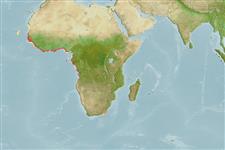Elasmobranchi (squali e razze) (sharks and rays) >
Myliobatiformes (Stingrays) >
Dasyatidae (Stingrays) > Urogymninae
Etymology: margaritella: Named for the smaller size of this stingray and of its pearl (Latin: margarita) spine, as compared to Dasyatis margarita (Ref. 26277).
More on authors: Compagno & Roberts.
Environment: milieu / climate zone / depth range / distribution range
Ecologia
marino; salmastro demersale; distribuzione batimetrica ? - 60 m (Ref. 114953). Tropical
Eastern Central Atlantic: West African coast from Cape Blanc in Mauritania to Angola (Ref. 7397, 81259, 81625, 114953). Often confused with Dasyatis margarita (Günther, 1870) (Ref. 7397).
Size / Peso / Age
Maturity: Lm ? range ? - ? cm
Max length : 30.0 cm WD maschio/sesso non determinato; (Ref. 81259); peso massimo pubblicato: 1.0 kg (Ref. 81259)
Vertebre: 116 - 128. Diagnosis: Dasyatis margaritella is the smallest dasyatid in West Africa (Ref. 26277). It is most similar to Dasyatis margarita, which is larger and has a larger pearl spine, and more numerous pectoral radials, 133-135 vs. 116-127 in D. margaritella (Ref. 26277). It is also similar to D. garouaensis, which has a much flatter disc and a longer snout (Ref. 26277).
Dasyatis margaritella is the most common littoral stingray on the West African coast and it enter lagoons, shallow bays and estuaries (Ref. 7397, 81259). Most likely feeds on small invertebrates (Ref. 114953). Ovoviviparous (Ref. 50449).
Life cycle and mating behavior
Maturità | Riproduzione | Deposizione | Uova | Fecundity | Larve
Exhibit ovoviparity (aplacental viviparity), with embryos feeding initially on yolk, then receiving additional nourishment from the mother by indirect absorption of uterine fluid enriched with mucus, fat or protein through specialised structures (Ref. 50449). Distinct pairing with embrace (Ref. 205).
Séret, B., 2003. Dasyatidae. p. 81-96. In D. Paugy, C. Lévêque and G.G Teugels (eds.) The fresh and brackish water fishes of West Africa Volume 1. Collection Faune et Flore Tropicales 40. Institut de recherche de développement, Paris, France, Muséum national d'histoire naturelle, Paris, France and Musée royal de l'Afrique Central, Tervuren, Belgium, 457p. (Ref. 81259)
IUCN Red List Status (Ref. 130435)
Threat to humans
Harmless
Human uses
Pesca:
Informazioni ulteriori
BibliografiaAcquacolturaProfilo di acquacolturaVarietàGeneticaElectrophoresesEreditarietàMalattieElaborazioneNutrientsMass conversion
CollaboratoriImmaginiStamps, Coins Misc.SuoniCiguateraVelocitàModalità di nuotoArea branchialeOtolithsCervelliVista
Strumenti
Special reports
Download XML
Fonti Internet
Estimates based on models
Preferred temperature (Ref.
123201): 23.7 - 28, mean 26.6 °C (based on 66 cells).
Phylogenetic diversity index (Ref.
82804): PD
50 = 0.5156 [Uniqueness, from 0.5 = low to 2.0 = high].
Bayesian length-weight: a=0.00832 (0.00366 - 0.01891), b=3.10 (2.90 - 3.30), in cm total length, based on LWR estimates for this (Sub)family-body shape (Ref.
93245).
Trophic level (Ref.
69278): 3.9 ±0.13 se; based on food items.
Resilienza (Ref.
120179): Basso, tempo minimo di raddoppiamento della popolazione 4.5 - 14 anni (Assuming fecundity<100).
Fishing Vulnerability (Ref.
59153): Very high vulnerability (90 of 100).
Nutrients (Ref.
124155): Calcium = 63.4 [13.9, 304.2] mg/100g; Iron = 0.84 [0.21, 2.38] mg/100g; Protein = 21.7 [18.8, 24.8] %; Omega3 = 0.222 [0.061, 0.662] g/100g; Selenium = 27.6 [8.0, 80.2] μg/100g; VitaminA = 34.4 [12.4, 91.8] μg/100g; Zinc = 1.38 [0.67, 2.66] mg/100g (wet weight);
